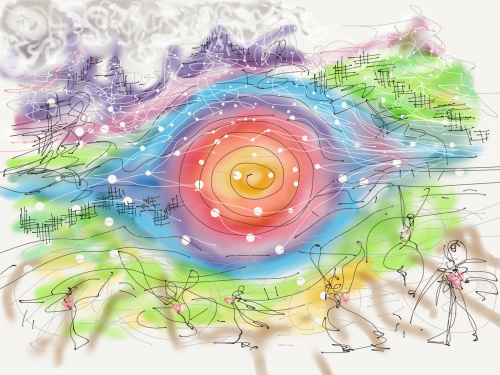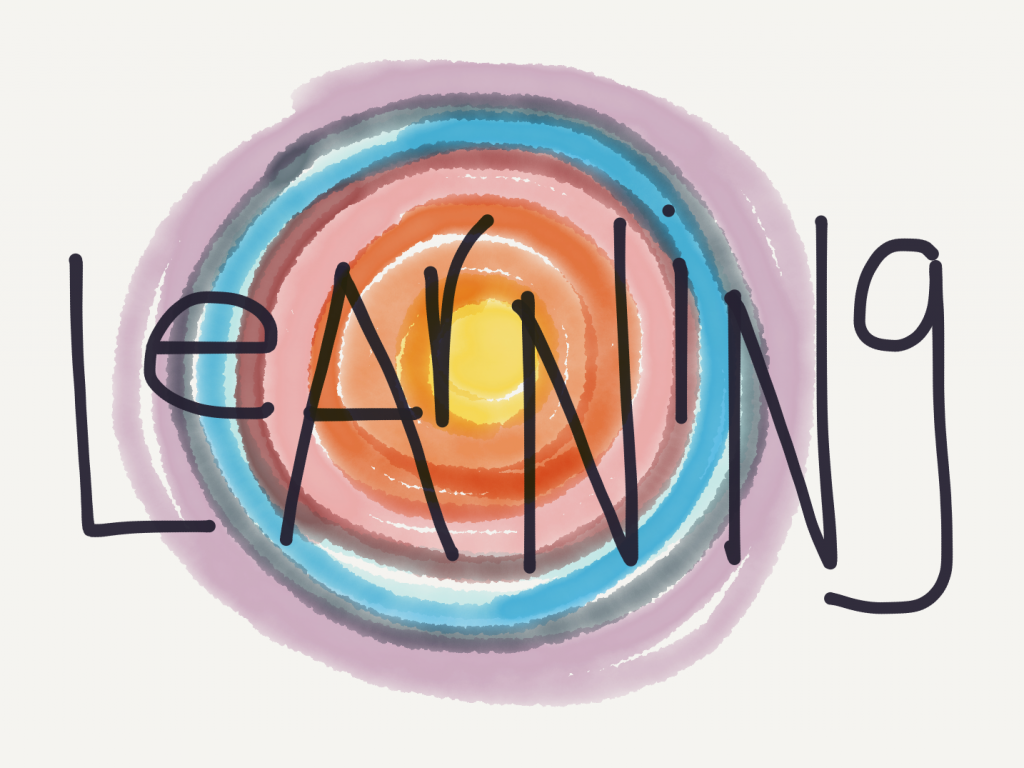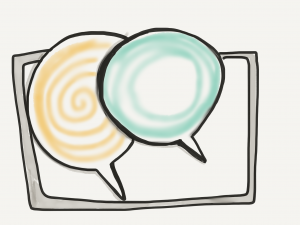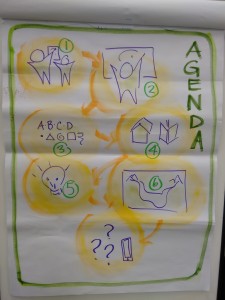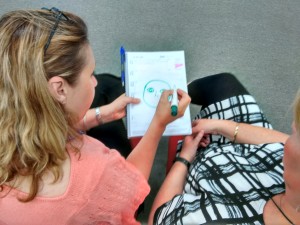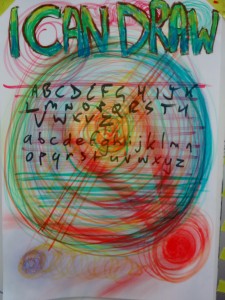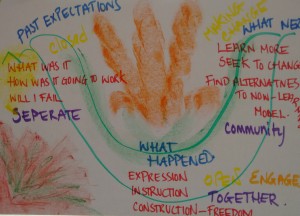 For the last 6 years we (Michelle and Nancy) have been leading introductory workshops on graphic facilitation, the use of visuals in group process. We’ve grounded the workshops in basic drawing “liberation” (I CAN DRAW), dipped into graphic recording and finished with examples of visual practices in group process. Last year Michelle took that on solo and will lead RosViz 16 again. If you are looking for a great entry point into graphic facilitation, JUMP AT THIS OFFERING for September 19-20, 2016 in Rossland BC. Add a few days and enjoy the stupendous beauty of the area!
For the last 6 years we (Michelle and Nancy) have been leading introductory workshops on graphic facilitation, the use of visuals in group process. We’ve grounded the workshops in basic drawing “liberation” (I CAN DRAW), dipped into graphic recording and finished with examples of visual practices in group process. Last year Michelle took that on solo and will lead RosViz 16 again. If you are looking for a great entry point into graphic facilitation, JUMP AT THIS OFFERING for September 19-20, 2016 in Rossland BC. Add a few days and enjoy the stupendous beauty of the area!
I am grateful Michelle took RosViz on, because in true restless Nancy form, I was ready to do something new, to push my own boundaries a bit further. Often that means WITH YOU! So I wanted to share our individual and collective offerings, this year in September in Rossland on September 16 and 17. Michelle has all the details on her blog about both offerings. And I want to add to my American friends, with the Canadian rate exchange, this is a good deal!
Now, the new offering, which maybe is a workshop, but I also think it is a do-shop, a think-shop and a play-shop!
My Pens, Our Pens: Engagement Through Participatory Visualization
September 16-17, 2016, Rossland, BC, Canada
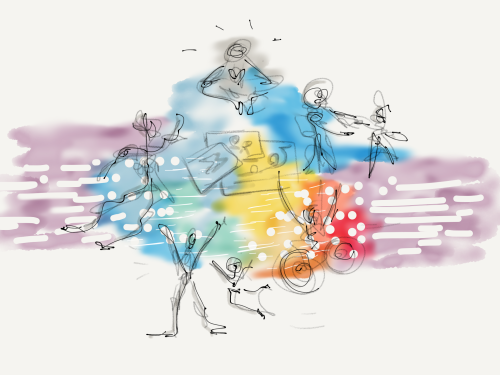
This year we are ready to push ourselves into some new territory from our practices and from the inspirations of other practitioners we follow and admire. We invite you to join us in this exploration.
For 2 days we will explore, share and practice participatory visualization practices which support group process. From templates pioneered by leaders in the graphic practitioner fields to ones we create on the spot, from visual exercises designed to promote relationship, thinking and sensemaking, to collaborative and collective visual harvest practices designed both for sensemaking and knowledge sharing.
We’ll start out in familiar territory getting comfortable drawing – but this year we’ll go beyond drawing on walls, and experiment with shared visualization on smaller scale paper and even, if you want, on tablets and ipads. Then we’ll progress through a series of exercises and experiments alternating with reflection and harvest. At the end of the 2 days you will have experienced, experimented, facilitated, reflected and made sense of how visuals can be part of participatory and engaging processes in your work.
This is not your traditional workshop. We are looking to push our boundaries (and yours) in terms of the role of visuals in design and facilitation. We will ask hard questions about who captures content and what is its use? Can visual methods help in developmental evaluation and results communication be more meaningful? What is the role of metaphor? It’s constraints? Where are there visual opportunities in process design? When does it make sense to use visuals and where does it detract from the process? What is the process of participatory capture and harvest of content? What are the power dynamics? How do we use visuals with approaches such as Liberating Structures?
Here are some of the themes we are exploring:
- The Influences of Different Modalities and Constraints on group interaction: opening possibilities
- Metaphor: friend and foe
- Visual Practices for Strategy/ Assessment / Evaluation: engaged and effective
- Visual Reflective Practice: personal and group
- Visually Communicating With Our Teams: shared language and attention
- Building a Visually Grounded Facilitation Practice (tools, resources, etc.): stuff you can use right away
To ground us, we’ll send you some readings and maybe an exercise or two in advance to jump start our time together. I have been curating some very cool stuff! Because this is an exploration, we want to look inward AND outwards, so we’ll actively share out to the world what we learn.
Who is this for? We invite everyone, from beginners, to RosViz alumni, to seasoned practitioners to join us. You are welcome to bring favorite drawing materials and electronic devices. We will provide with a drawing journal, a set of marker pens, a sketchnote pen and 2 different colors of pan pastels with a sponge. You will have access to loads more materials to play with and use throughout the workshop. If you know us, you know there will also be healthy snacks and chocolate. We also host a very active online community of practitioners to support your practice and learning after the workshop.
Visual novices or those wanting to brush up on their drawing skills will be invited to an optional pre-session of our more traditional “drawing on walls” the day before. There is an additional fee and it includes an additional set of chalk pastels. However, this is not required and will only be offered if we have 4 or more interested people.
Dates: Sept 16, 8-5 & Sept 17 – 8-3
(Please arrive the night before if flying in. We end at 3pm on Sept 17 so people can catch flights home)
*Getting started drawing on walls optional ‘pre-day’ is Sept 15, 2- 6pm
Price: $950 CAD + GST (Intro to Drawing on Walls + $300 CAD)
*Early bird discount $800 CAD + GST (register and paid by July 15th)
*Bonus: Three or more from one organization, 4th comes free!
Location: Prestige Hotel Ballroom, beautiful Rossland, BC
Meals: All meals on your own. Rossland has several beautiful cafes and restaurants to enjoy. Healthy snacks, chocolate and drinks are provided throughout.
About your hosts:
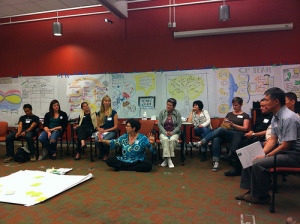
Nancy White
“I am a learner, mom, gramma and chocoholic. I founded Full Circle Associates to help organizations connect through online and offline strategies. My practices are diverse, including online interaction designer, facilitator and coach for distributed communities of practice, online learning, distributed teams and online communities, doodler and visual practitioner. I have a special interest in the NGO/NPO sector and the emerging practice of using communities and networks for work and learning. I blog at http://fullcirc.com/wp/, teach, present and write on online facilitation and interaction, social architecture, social media and visual practices. I am co-author with Etienne Wenger and John Smith of Digital Habitats: stewarding technology for communities. Lately not only do I like to draw on walls (graphic facilitation), but I spend a lot of time playing with my granddaughters!!! For more about my visual practice see http://fullcirc.com/wp/about/visual-and-graphic-work/.”
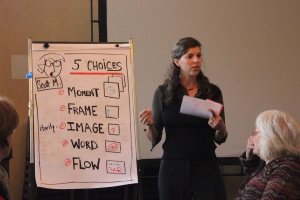
Michelle Laurie
“Despite being an analytical person, I have found that visuals have brought new meaning to my practice as a facilitator and communicator. Typically I explore the interface of environment and development via strategic planning, assessments, facilitation and engagement. Lately my work has focused on supporting organizations to transform their ideas for positive change into realities on the ground. I incorporate visuals wherever I can particularly with the use of participatory graphics, templates, animation and reporting. I also use visuals in my personal life for planning weddings, family activities and travels! I am an associate with the International Institute for Sustainable Development, a member of the International Association of Facilitators, the Canadian Evaluation Society and IUCN’s Commission on Education and Communication. I will be your main contact for workshop logistics.”
To register you must email michelle.k.laurie(@)gmail.com to confirm your participation, provide your contact details and submit payment.
Payment Options:
– Email transfer – michelle.k.laurie(@)gmail.com
– Paypal transfer – paypal.me/MichelleLaurie (If you prefer to pay in USD, contact NANCY)
– Cheque by snail mail to: Michelle Laurie, PO Box 1063, Rossland, BC, V0G 1Y0, Canada
